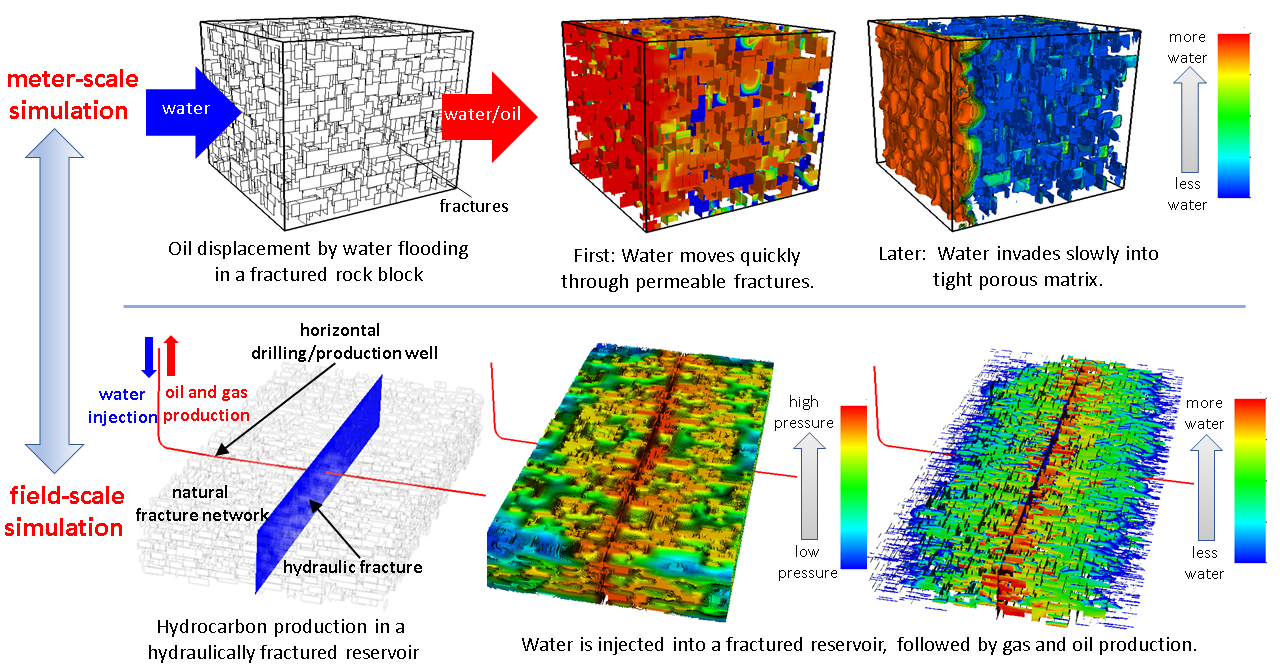Yue Hao (16-ERD-014)
Executive Summary
Our research will represent a major advance in simulating fractured shale reservoirs, helping interpret field data that cannot be currently well explained. We are developing a discrete-fracture multiphase flow model with improved physics, an up-scaling method from discrete fracture to continuum models, and coupled hydraulic-fracture and flow models, which will lead to improved shale gas and oil recovery operations.
Abstract
From deep, geological storage of carbon dioxide and geothermal energy extraction to subsurface radionuclide or contaminant migration, understanding multiphase flow and transport in fractured media is a critical requirement. A recent and important example of multiphase flow between fractures and matrix rocks is related to hydraulic fracturing (fracking), which involves drilling and injecting aqueous fluids at high pressures into low-permeability shale rocks. This process creates new fractures or reactivates existing fracture networks to maximize formation permeability for enhanced shale gas or oil production. Despite recent and widespread commercial successes of this approach, two major issues challenge current hydraulic fracturing operations. First, newly fractured unconventional wells experience a much faster production decline than conventional wells, requiring continuous drilling and re-fracturing to remain economically viable. Second, large amounts of injected fluids are lost within reservoirs during hydraulic operations, driving up already high costs and increasing potential risks for environmental damage. We are developing a high-fidelity discrete-fracture model to simulate multiphase flow in fractured shale rocks (see figure). The work would represent a major advance in simulating fractured shale reservoirs, helping interpret field data that cannot be well explained by current models. We plan to develop a discrete-fracture multiphase flow model with improved physics, as well as an up-scaling method from discrete fracture to continuum models. In addition, we will couple hydraulic-fracture and flow models. Such work has the potential to enhance a wide range of energy, national security, and environmental programs such as unconventional hydrocarbon recovery, enhanced geothermal systems, geological carbon dioxide storage, and subsurface radionuclide or contaminant migration such as the Comprehensive Test Ban Treaty on-site inspection and Underground Test Area projects.
We expect to provide an improved understanding of the physical processes that influence shale gas and oil production and hydraulic fracturing, as well as a first-of-a-kind flow-modeling capability including discrete fractures and improved physics that governs multiphase flow processes in fractured shale reservoirs. Specifically, we intend to (1) develop a numerically robust discrete-fracture multiphase flow model in the GEOS hydraulic fracturing simulator to improve fidelity and accuracy in representing fracture–matrix interactions; (2) include physical models of relevant multiphase flow phenomena within the discrete-fracture model to capture flow and transport in discrete fractures and surrounding low-permeability rocks; (3) develop an up-scaling approach to improve how multiphase flow and transport in fractured rocks can be represented in field-scale models, bridging conceptual gaps between discrete-fracture and continuum models; (4) integrate hydraulic-fracture and multiphase flow models for simulating coupled physical processes during hydraulic fracturing and hydrocarbon production; and (5) perform model validation and verification. Our models will lead to improved interpretive capabilities of shale gas and oil recovery operations, as well as a basis for upgrading legacy models for predicting and designing shale gas and oil recovery operations. In addition, we expect our simulations to provide a major advance in modeling multiphase flow in fractured media.
Mission Relevance
Our research project will provide a first-of-a-kind demonstration of discrete-fracture modeling of multiphase flow in fractured reservoirs, leading to a more accurate understanding of the physical processes that affect shale gas and oil recovery. This effort will enhance the Laboratory's mission focus area in energy and climate security and support the DOE mission of energy security by enabling a more economically competitive, environmentally responsible, secure, and resilient U.S. energy infrastructure. The resultant fully integrated geological–mechanical and reservoir modeling capability and the addition of a multiphase flow-simulation element to the GEOS hydraulic fracturing simulator also supports LLNL's core competencies in Earth and atmospheric science as well as high-performance computing, simulation, and data science.
FY17 Accomplishments and Results
In FY17 we (1) developed a black-oil model in the discrete-fracture modeling framework to simulate water, oil, and gas flow behaviors in fractured shale reservoirs; (2) verified and validated the model using analytical and numerical benchmark solutions, as well as field production data; (3) integrated the related physical sub-models to examine capillary effects on unconventional hydrocarbon production; (4) built a preliminary simulation framework to couple multiphase flow and models based on soil and rock mechanics; (5) tested the model for different subsurface applications; and (6) continued to improve the model to capture shale-gas slip flow, adsorption and desorption, and up-scale flow and transport processes from discrete-fracture to continuum scales.
Publications and Presentations
Hao,Y., et al. 2016. "Discrete fracture modeling of multiphase flow and hydrocarbon production in fractured shale or low permeability reservoirs." 2016 American Geophysical Union Fall Meeting, San Francisco, CA, 12–16 December 2016. LLNL-ABS-699899.
———. 2017. "Numerical evaluation of multiphase flow processes and their effects on hydrocarbon production in hydraulically fractured reservoirs." 9th International Conference on Porous Media and Annual Meeting, Rotterdam, Netherlands, 8–11 May 2017. LLNL-ABS-709521.
   






